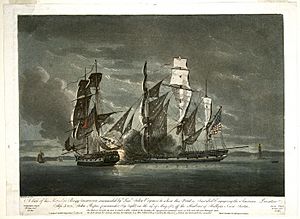Battle off Halifax (1782) facts for kids
Quick facts for kids Battle off Halifax |
|||||||
|---|---|---|---|---|---|---|---|
| Part of the American Revolutionary War | |||||||
 Battle off Halifax by Robert Dodd |
|||||||
|
|||||||
| Belligerents | |||||||
| Commanders and leaders | |||||||
| Strength | |||||||
| 1 privateer | 1 brig | ||||||
| Casualties and losses | |||||||
| 7 killed 13 wounded 1 privateer captured |
3 killed 5 wounded |
||||||
The Battle off Halifax was an important naval fight during the American Revolutionary War. It happened on May 28, 1782, near Halifax, in Nova Scotia. This battle was between an American ship called Jack and a British ship named HMS Observer.
The Jack was a privateer, which was like a private ship allowed to attack enemy ships during wartime. The Observer was a 14-gun brig, a type of sailing ship, belonging to the Royal Navy. Captain David Ropes led the American ship Jack, and Lieutenant John Crymes commanded the British ship Observer. It was a tough battle where Captain Ropes was killed.
Contents
Why This Battle Happened
American Privateers in Nova Scotia
During the American Revolutionary War, American ships often attacked Nova Scotia. These attacks were mostly by privateers. Privateers were private ships that had permission to attack and capture enemy ships. They caused a lot of trouble for the local economy. They would raid coastal towns, like Liverpool and Annapolis Royal.
There were other naval battles in this area before the fight between Jack and Observer. For example, in 1777, a British force captured the American frigate Hancock near Halifax. This showed how important it was for the British to control the waters around Nova Scotia.
Another big fight happened on July 10, 1780. A British privateer called Resolution fought an American privateer named Viper. This battle was very intense, with both ships firing cannons at each other for about 90 minutes. Many sailors were killed or wounded.
The Ship Jack Before the Battle
The American ship Jack had been in battles before. It was first used as a privateer in 1779. It had captured several enemy ships. However, in July 1780, British ships captured Jack in the St. Lawrence River.
The British then used Jack for their own patrols. But in 1781, French ships captured Jack near Cape Breton Island. The French took Jack to Boston, where its original American owners bought it back. They sent it out again as a privateer.
The Ship Observer Before the Battle
The British ship Observer was also a captured ship. It used to be an American privateer named Amsterdam. A British ship captured Amsterdam in October 1781. The British Navy then bought it and renamed it Observer.
The Battle Off Halifax
How the Fight Started
On May 28, 1782, the British ship Observer was sailing back to Halifax. It had just rescued some sailors from another ship who were stuck on Seal Island. As Observer got close to the Sambro Island Light, which is near the entrance to Halifax Harbour, the American ship Jack came into view.
At first, Jack thought Observer was an easier target. But when the Americans realized Observer was a British Navy ship, they tried to get away.
The Chase and the Fight
The Observer chased Jack for two hours. The two ships were very similar in size and power. When Observer finally caught up, the battle began.
Right away, the British fired their cannons, and the American captain, David Ropes, was killed. Both ships were hit many times, and their sails were full of holes. The British sailors tried to climb onto Jack to take over the ship. The Americans fought them off at first. But the British kept trying and eventually succeeded. The Jack finally gave up and lowered its flag on the afternoon of May 29.
What Happened Next
Even after this battle, American privateers continued to be a danger to ports in Nova Scotia. Just a month later, American privateers tried to attack Chester, Nova Scotia. When that failed, they successfully raided Lunenburg in 1782.

